Your Backyard Wildlife Habitat: Begin in Spring to Control Fleas
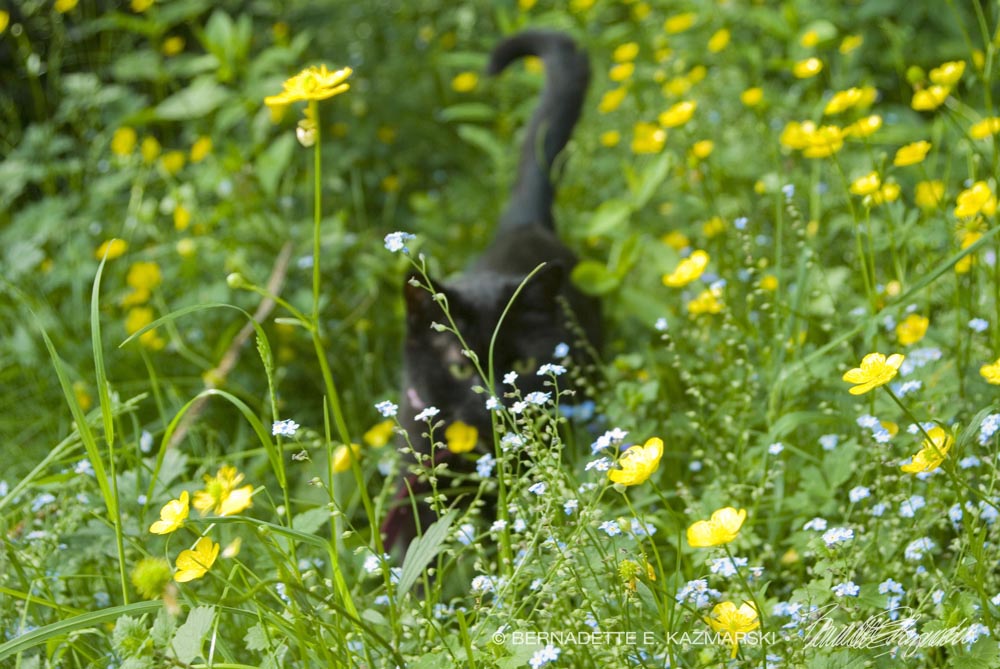
FLEAS, LIKE MOST OTHER INSECTS, live everywhere around us and it’s how we manage our surroundings that helps to control their populations. Like managing mosquitoes, for instance, by eliminating still pools of water where they can breed, you can also manage the flea population around your yard without the use of toxic chemicals so that fleas can’t set up a happy colony where they are ready and waiting when your pet comes outside—or even when you come outside and carry them back in.
. . . . . . .
Spring is the prime time to get ahead of fleas, so take spring cleaning in your yard as seriously as in your home and begin early. By initiating or modifying a few of the ways you care for your landscape you can eliminate nesting and breeding spaces and welcome their predators, an effect that can last all through the warm months of summer and fall, and even become a permanent solution to keeping fleas at a minimum in your yard. If you manage cats in an outdoor colony some of these suggestions can help you with flea control in their area as well.
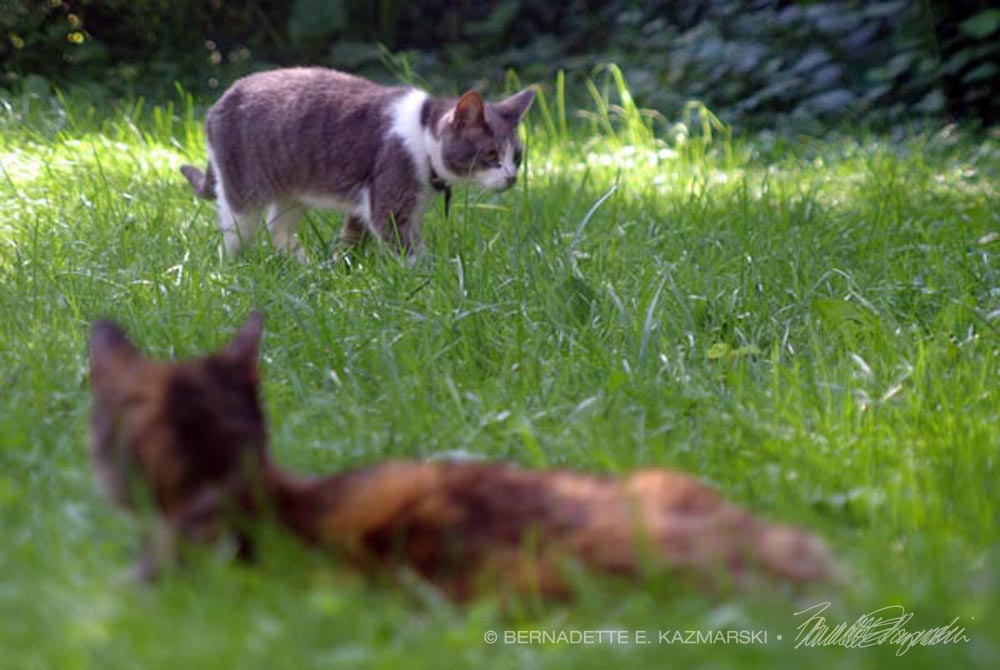
Where Do Fleas Come From?
Fleas begin in the great outdoors, even in the nicest yard, and don’t think that simply because you don’t let your pet outside, or it’s only outside for a short while, that fleas won’t find them. Fleas are tiny and can hop amazing distances to get to a warm body for their blood meal. They will be attracted to your body because you are warm and though they don’t generally feed on humans they will bite you just to see how it works. They can ride into your home on your own body and clothing and jump off as you greet your pet at the door. Encountering another animal that has fleas either on a walk outdoors or even at the veterinarian’s office can infest your pet without it ever setting a paw in the back yard.
But fleas are slow to wake up in the spring and are a snack for a number of predator insects. These two facts of their life cycle help you to get ahead of them.
Integrated Pest Management
I’ve always taken one or more of my cats into my back yard, so I’ve always included fleas in my pest management along with the likes of aphids and tomato hornworms. Adult fleas are very particular about moisture and temperature, but flea eggs can live through a lot of punishment and still hatch and carry on the next generation so they need to be managed from year to year, not just for the summer.
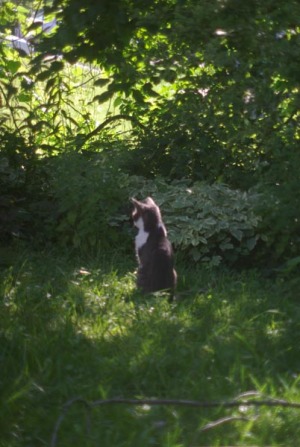
Aside from the dangers of insecticide toxicity to your pet who is walking trough a treated area and taking it in though their paws, noses and skin, using an insecticide generally kills off all the insects in an area, not just the ones you are targeting, and has even been implicated in the reduction of bee populations worldwide and even the deaths of songbirds and endangered mammals. Where fleas are concerned, an insecticide just kills the adult fleas which are only about 10% of the total flea population. There may be some residual left to kill the adults as the eggs hatch and larvae mature into adults, but with unpredictable weather it’s often washed away before it does any good.
Pest insects have adapted to reproduce more quickly than their prey so after an application of chemical pesticide the fleas will return long before their predators return, resulting in a more serious infestation than before. Without any predators you really need to keep applying the chemical, but all you do is knock down the numbers, never winning the game. This often results in killing off all predators, and not just those of fleas, and even driving them away, while building up toxic levels in your soil which run off into local waterways, affecting more wildlife than you ever intended.
It’s obvious that species have been kept in balance for millennia by some means outside of human controls. I am a Master Gardener and began years ago to start my own plants, identify seedlings, diagnose pests and diseases and build soil. I manage my little yard as a wildlife habitat, friendly to all native species as well as the plants I choose to grow and have always called on the forces of nature to manage the populations as an ecosystem, allowing it to find its own balance, and this has worked for managing fleas as well as other insect pests in my lawn, vegetable garden, flower beds and natural areas.
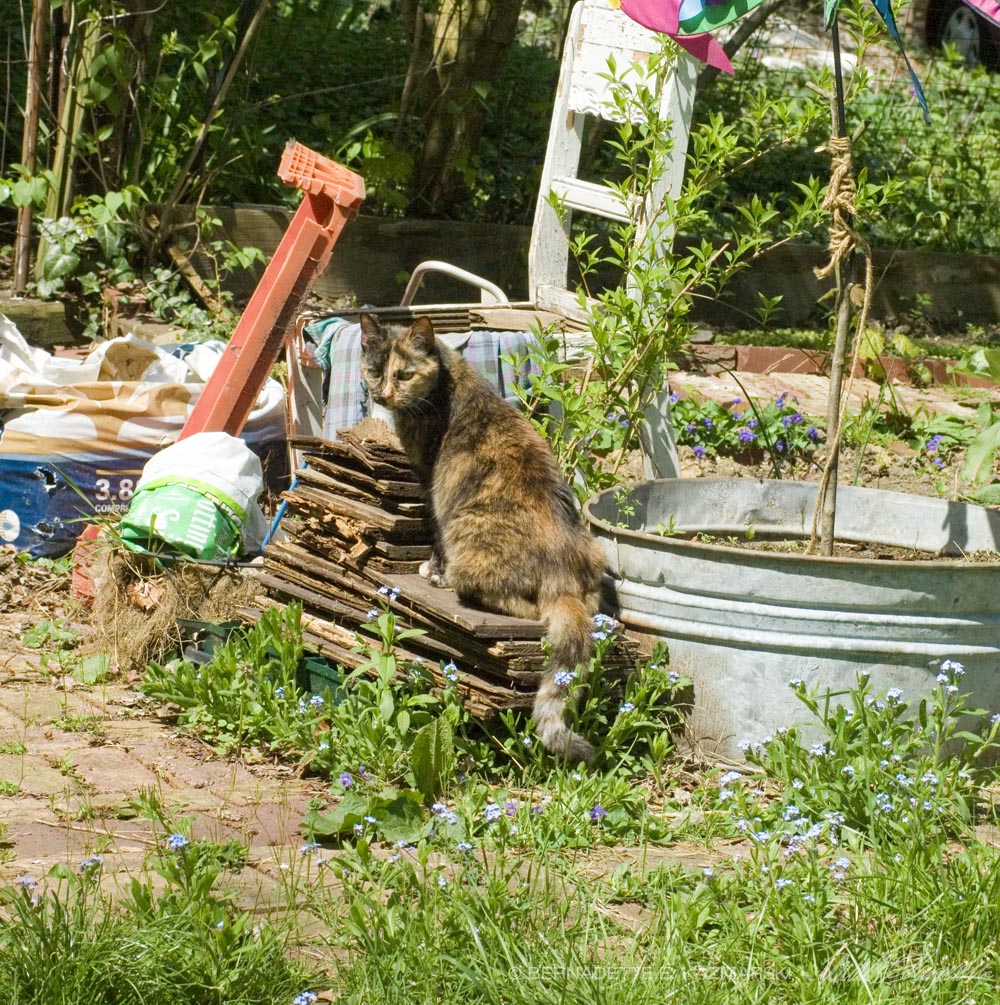
The two basic steps in managing any pest that outgrows its controls are:
- find out where it lives and destroy that habitat to any extent possible
- then find its natural predators and encourage them to inhabit and flourish, forever if possible.
Flea Habitats
Fleas live in moist, shady areas in the yard, in the thatch in your lawn, debris piles, leaf litter, cord wood stacks and even under your deck or porch unless it’s completely dry. They’ve often overwintered in these areas and with the moisture of spring eggs start hatching as soon as it’s warm enough and shady after trees and shrubs have leafed out. One thing to remember about when fleas hatch is that they wait until temperatures rise above 60 degrees at night or 70 degrees during the day.
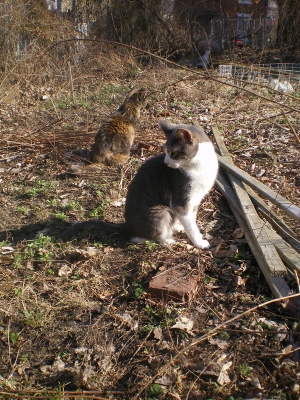
Spring Cleaning
One of the first things I do in spring, way before fleas hatch, is clear off all the debris in the yard and toss it in the compost pile, which as the materials break down heats up to a point that kills any eggs or seeds within it; if you don’t have a compost pile see if you can burn your yard debris or send it off to your municipal composting center. If none of these are available, I hate to advise to throw it away, but if you feel there are fleas infesting it it’s best to just get rid of it. Just don’t keep it around, piled in a corner, or it can become a breeding ground for everything that laid eggs in it last year.
I leave all plants standing for wildlife through the winter, but in spring it’s all taken down, even mowed if possible, then raked in order to remove possible pest habitat (including plant diseases which may have overwintered). This helps immensely with reducing the initial populations and you’ve also destroyed a lot of eggs and habitat for many insect pests.
This also helps to delay the onset of fleas in your yard, but they’re going to start hatching some time regardless of chemical or organic controls, so be prepared with methods to manage flea populations through their life cycle.

Manage Areas Fleas Prefer
To start with, try to minimize or eliminate damp and densely shaded areas in your yard—underneath a shrub, for instance, often a favorite place for pets to hang out on hot days because it’s cooler and the soil is a little damp. It’s absolutely flea heaven, especially if you’ve either left the leaf litter from last year or added some decorative bark or wood chip mulch. This one area can support three stages of the flea: eggs can be laid here, the larvae can live on organic matter, and they can build their cocoons here as well, hatching into adult fleas that feed on your kitty taking a nap in the shade.

My yard tends to be very damp and I also have a slug problem (that’s an understatement), and for years I’ve sprinkled diatomaceous earth (DE) in all the moist shady areas for the slugs that feast all night, also taking care of a good many fleas. This product is not soil at all but the shells of diatoms, tiny sea creatures, crushed to a fine powder. Sea shells are actually formed of minerals and while the powder looks like dust it is actually very tiny, very sharp particles that cut into the exoskeleton of the flea, causing it to dehydrate and die. It does the same thing to slugs, but other creatures, from earthworms to birds, and even you and your pets, simply digest it with no ill effect. Its effect is completely physical with no chemical effect at all so nothing enters the blood stream or needs to be metabolized. One caution is that inhaling the fine powder can be irritating to sinuses and lungs of people or pets with breathing issues. I have used it indoors and out for decades, living with cats of all ages and health conditions and never seen it cause any problems. One other benefit is when it’s digested it is also said to help with internal parasites through the digestive system. I have seen this in my own household and others’ and farmers who manage cows and pigs and horses tell me they swear by it to control various worms, but I have not found a study to prove it—I hope someone does one soon!
Diatomaceous earth has a short-term effect outdoors, though, because it mixes with soil and other organic matter, diluting its effect, and is washed away by rain or even heavy dew, but generally sprinkling it weekly in damp shady areas through the summer is a good plan. Just make sure it’s the DE listed as “food grade” intended for gardening use NOT pool use because for your pool it has chemicals added, and wear a mask when you sprinkle it because prolonged inhalation can cause some respiratory discomfort, as described above. It comes in a bag and you can sprinkle it by the handful, but a helpful hint for sprinkling is to save a container with a perforated lid such as parmesan cheese or larger spice containers that have removable lids—just be certain to clearly label your container with DE so that you or anyone else picking up the container doesn’t sprinkle DE on their pasta.

At one time I freely used pyrethrum-based products to control fleas and other insect pests indoors and out, and while pyrethrins break down quickly in sunlight and are diluted by water, tests later showed that if they are not in conditions that break them down they can build up in soil and in the home, and can be toxic to some flora and fauna outdoors, and children and pets indoors. Most organic gardeners quit using them long ago, though they are still sold for outdoor treatment as well as specifically flea control products. I have included a link to the CDC report at the end of this article.
Modify Your Lawn
Also manage your yard, especially your lawn, to encourage flea predators. Beneficial nematodes should be on everyone’s shopping list for gardening supplies for their qualities as a natural pest control method. Apply them to damp and shady areas as well as the DE, especially where you can’t change the conditions by trimming shrubs or cleaning up debris such as a bed of heavy ground cover like ivy or pachysandra, or where you’ve landscaped with mulch, sand, gravel or small stones. Unlike the DE they don’t wash away but live in the soil, ready to feast on the insects you don’t want. You may need to reapply every year or two; this was my experience, but they definitely keep populations down while they persist—and not just fleas.
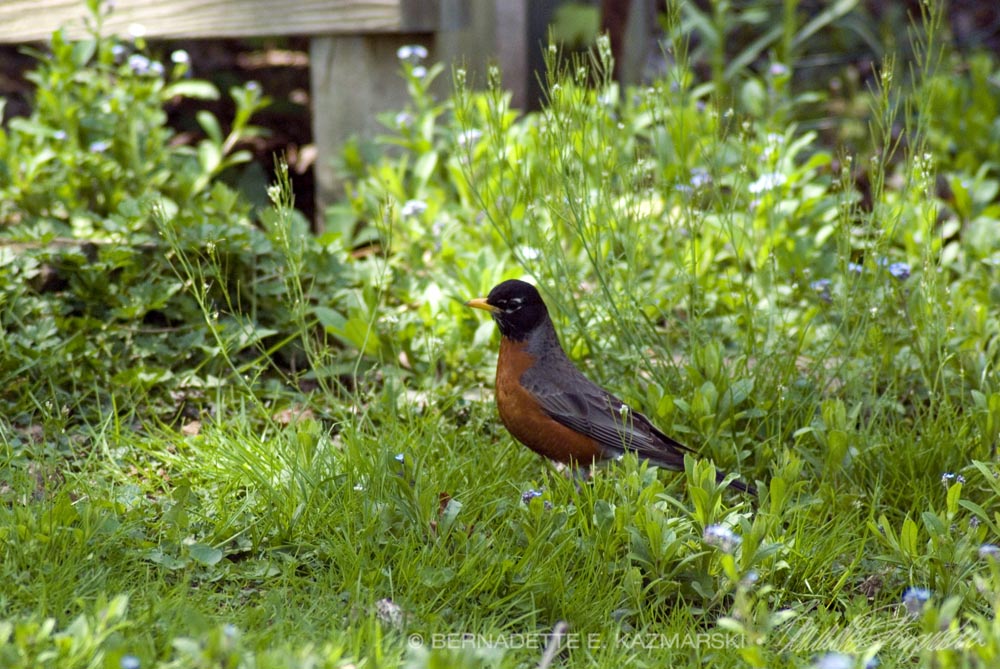
Natural Predators
You can also encourage the flea’s natural predators to come and live in your lawn and garden. Insect predators include ants, spiders and ground beetles, other species include amphibians such as toads and salamanders, reptiles such as garter snakes, and even birds that feed on the ground.
Hmmm… you don’t like spiders and snakes, and everything else sounds like something you don’t want anywhere near your house, except maybe the birds? Trust me, they are much more interested in their natural diet than they are in you, and unless you go looking you’d never know they’re there—except that you’d have fewer fleas and other pest insects generally.
Welcome them by managing your lawn in a way that might be different from the typical grass-only buzz cut, incorporating native plants and herbs and allowing your lawn to grow a little taller. My lawn is only about half grass, while the rest is a mixture of short native plants and ground covers, plus opportunistic peppermint, pennyroyal and marjoram escaped from my herb gardens and the seedlings for next year’s forget-me-nots, daisies and other biennials and spring ephemerals. This diversity of flora encourages a diversity of fauna and eliminates large areas of one type of habitat so nothing has a chance to overpopulate. Plus, it smells great when you cut the grass.
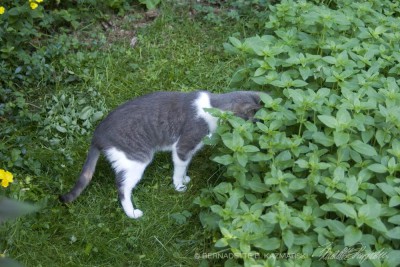
Pennyroyal and peppermint move about my yard as mint will do, and I let them grow wherever they appear in my lawn. Both are natural pest deterrents, and the more that’s mixed in with my lawn, the fewer insects will inhabit that area and the less grass I will have for insects who lay their eggs on grass. Though cats don’t care for the smell of mint, small critters do and Namir could regularly be found prowling around the mint patches.
Because I have less grass, I only have to cut the lawn about once a month after May. The native plants have a predetermined growth habit, most of them staying below six inches with a set bloom time so successive generations of plants grow, bloom, and retire to just leaves. After the spring flush of growth the grass grows much more slowly and I can cut it higher than two inches, the minimum height to encourage ants and spiders, the main predators of fleas. Cutting the grass taller and less often helps the predators develop habitat and do their job on the fleas, but this does not mean never cutting it at all, which completely reverses all the things you are trying to accomplish.
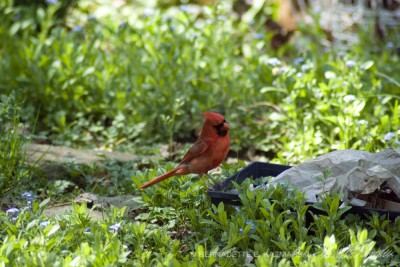
I also feed birds year-round, and while I always credit them with keeping vegetable and flower pests under control, I know they also peck around through the grass eating fleas, especially when I see robins flipping the mulch and starlings and grackles marching in formation while pecking at the soil.
Another natural predator, if you are permitted to have them, chickens do a fantastic job of eating up all the fleas along with ticks and other insects you don’t want.
Even if you’ve done all this you can still expect a few fleas. But you’re suddenly totally infested—what else can it be?
Wildlife
It’s that darned squirrel that hangs out on your deck, or the groundhog that’s burrowed underneath it—or the opossum that nested in your piled-up porch furniture until spring, or the little field mice and voles who sacrifice themselves to your cats in the basement. All of these have infested my house until I realized these animals had nested very near my doors and there really were squirrels in my attic.

I had sprinkled the house with diatomaceous earth, bathed and combed the cats regularly, washed everything washable, swept everywhere just about daily, removed throw rugs and pillows and such, tossed non-washable things into a hot dryer, and removed as much from my house as possible. This was all I needed to do for years and the flea population never reached an infestation.
But one particular year the fleas kept coming back, and increasing all the time. Where were they coming from?
I began to notice that when I walked out on my deck, which varies between five and ten feet off the ground, my legs were immediately covered with fleas, a dozen or more at a time. Fleas don’t fly, they jump, and while they can jump far, in a situation like this you can move around and check the numbers of fleas that jump on your skin (or wear a pair of white socks so you can see them easier) to help pinpoint an area of infestation. I started stepping around the deck, knocking fleas off my legs into a cup of water, then stepping again to see where numbers seemed the worst.
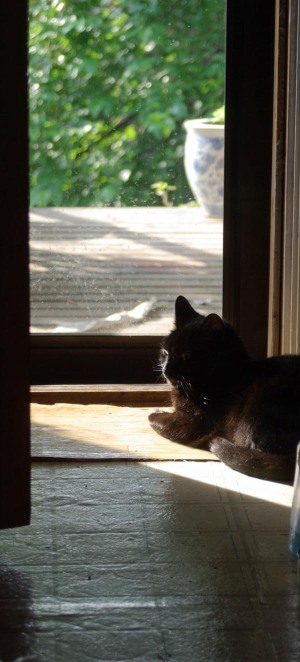
Most wild animals harbor a few fleas, and some species are typically infested. My squirrels spend about half their time scratching, and wild rabbits, chipmunks, gophers, mice and voles can also be heavily infested with fleas. The squirrels hang out on my deck trying to get into the bird seed, the rabbits hop around near the basement door, and I always have a juvenile groundhog who excavates under my deck before I can deter it, chipmunks run around chirping everywhere, and field mice and voles really do show up in my basement.
And I really did have an opossum on my deck that winter. Being nocturnal, we didn’t cross paths though I saw her through the back door now and then. With the unusually heavy ice and snow I didn’t have the heart to encourage her to find another home, and I didn’t unpack all my deck furniture that year, so I have no idea how long into spring she stayed.
It was the area right in front of the door—right over the groundhog den under the deck—and on one side of that unmoved pile of deck furniture. The groundhog had left my yard to eat someone else’s vegetable garden, but left the fleas behind and I’d dumped DE in the area he’d stayed under the deck, but he had burrowed pretty far underground. I began deconstructing the pile of porch furniture and found evidence of nesting, though not recent, but was immediately peppered with a heck of a lot of hungry fleas.
So this was the source of my infestation, right outside the door that I kept open for most of the summer, locking the screen door at night and when I was away. The screen stopped most of them, but fleas could hop in when I opened the door, and ride inside as I walked in and out the door. My basement door has a space at the bottom because the concrete walk just outside is uneven so I trimmed the bottom of the door.
Normally every spring I clean off my deck, sweep, wash and apply water-based waterproofing to the wood, then move things back, but for a couple of years I didn’t have the time, and it does have a roof. Once I cleaned off the deck, swept and washed it as well as hosed down all the items that were there, the constant re-infestation stopped, though I had a mess to deal with in the house. Whew!
Beware of ticks and other nasty insects
While this information will help you manage fleas and mosquitoes and many other insects as well, it has little, if any, effect on ticks. If you are in an area where heartworms or Lyme disease or other insect-borne disease is prevalent, you will still want to consider treatments specifically for these. These practices will greatly reduce the numbers of other insects and will not harm the environment, but will not eliminate the possibility of these diseases.
Some Resources for Chemical-Free Outdoor Flea Control
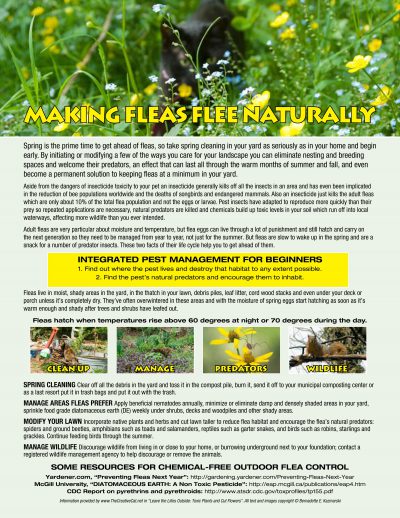 I’ve put together a downloadable guide of the basics of Integrated Pest Management and tips on how to manage your yard without using chemicals.
I’ve put together a downloadable guide of the basics of Integrated Pest Management and tips on how to manage your yard without using chemicals.
Download PDF flyer (best for desktop computers).
Download JPG flyer (best for mobile devices).
Articles to read
You can get ten pages of results or more in an internet search on flea control, diatomaceous earth, pyrethrins and so on, but I try to find studies or information from non-commercial educational sources to cite.
Yardener.com has a series of articles about dealing with fleas in your yard, and the article about preventing fleas in the future is especially informative—plus the site is a great resource for dealing with all sorts of pest problems in your yard. Preventing Fleas Next Year: http://gardening.yardener.com/Preventing-Fleas-Next-Year
Even though this article is from 1986, it gives a brief history of the use of diatomaceous earth from a study project at McGill University that is still applicable today about the effects and usage of DE.
http://eap.mcgill.ca/publications/eap4.htm
CDC Report on pyrethrins and pyrethroids: http://www.atsdr.cdc.gov/toxprofiles/tp155.pdf
Read other articles in the category of Your Backyard Wildlife Habitat
If you’re interested in more information about Backyard Wildlife Habitats, choose the category Your Backyard Wildlife Habitat for a list of articles in this series, visit the Backyard Wildlife Habitat page for a series articles on developing your habitat or choose the category Backyard Wildlife Habitat to find all posts sharing the articles, photos, paintings and sketches, poetry and prose I’ve done that were inspired but my backyard.
Backyard Wildlife Habitats

My backyard wildlife habitat was certified through National Wildlife Federation’s program in 2003, and their site is still one of my favorite references for information. Visit and read about it, and begin planning your own and be certified!
. . . . . . .
Read the entire series of introductory articles:
An Introduction to Backyard Wildlife Habitats
What’s in Your Backyard? The First Step in Planning Your Backyard Wildlife Habitat
What Else is in Your Backyard: The Fauna That Fill It
Bringing it All Together: Enhancing and Developing Your Habitat
. . . . . . .
Also read about my art, photography, poetry and prose inspired by my backyard wildlife habitat:
Art Inspired by My Backyard Wildlife Habitat
Photography Inspired by My Backyard Wildlife Habitat
Poetry Inspired by My Backyard Wildlife Habitat
Prose Inspired by My Backyard Wildlife Habitat
Or just read other articles in the category of Your Backyard Wildlife Habitat
Subscribe to my quarterly Nature & Wildlife e-newsletter
Click here to see my most recent newsletter and subscribe.
Gifts featuring cats you know! Visit Portraits of Animals
Fine Art • Photography • Gifts • Greeting Cards • Books • Commissioned Portraits & Artwork
Photography and Artwork Originals, Prints and Greeting Cards
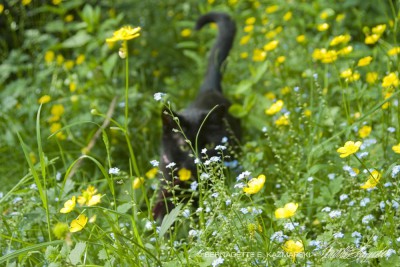
Mimi is never so happy as when she’s out in the yard, as you can see by her “happy tail”. She’s so short that I can’t get a good photo of her face without flowers in the way, but perhaps that’s how she wants it.
Click here to see more and browse my website for felines, wildlife, flowers, butterflies and more.

Copyright
All images and text used on this site are copyrighted to Bernadette E. Kazmarski unless otherwise noted and may not be used without my written permission, although links to your site are more than welcome and are shared. Please ask if you are interested in using and image or story in a print or internet publication. If you are interested in purchasing a print of an image or a product including it, check my animal and nature website Portraits of Animals to see if I have it available already. If you don’t find it there, visit Ordering Custom Artwork for more information on a custom greeting card, print or other item.
Subscribe to my e-newsletter
Subscribe to The Creative Cat Preview E-newsletter.
© 2022 | www.TheCreativeCat.net | Published by Bernadette E. Kazmarski
Weekly schedule of features:
Sunday: Essays, Pet Loss, Poetry, The Artist’s Life
Monday: Adoptable Cats, TNR & Shelters
Tuesday: Rescue Stories
Wednesday: Commissioned Portrait or Featured Artwork
Thursday: New Merchandise
Friday: Book Review, Health and Welfare, Advocacy
Saturday: Your Backyard Wildlife Habitat, Living Green With Pets, Creating With Cats
And sometimes, I just throw my hands in the air and have fun!
PORTRAITS OF ANIMALS WEBSITE
FACEBOOK | TWITTER | LINKEDIN | PINTEREST | TUMBLR | INSTAGRAM | YOUTUBE| EMAIL | PATREON




Pingback: Your Backyard Wildlife Habitat: Fall Cleanup, Bird Feeding and Fleas - The Creative Cat
Pingback: Your Backyard Wildlife Habitat: Begin in Spring to Control Fleas ~ The Creative Cat
Pingback: Your Backyard Wildlife Habitat: Fall Cleanup, Bird Feeding and Fleas ~ The Creative Cat